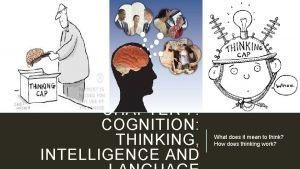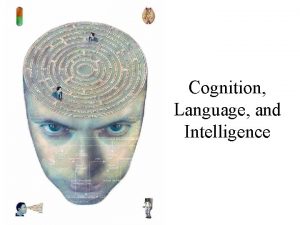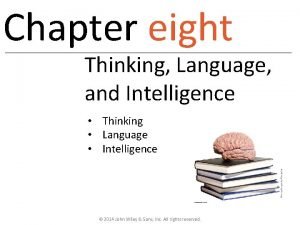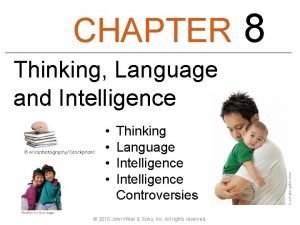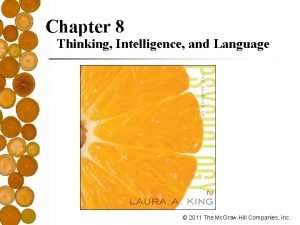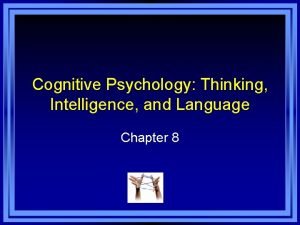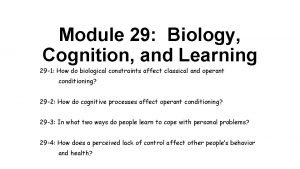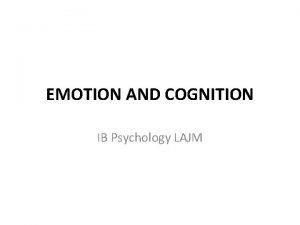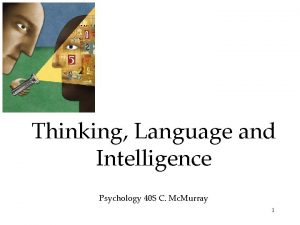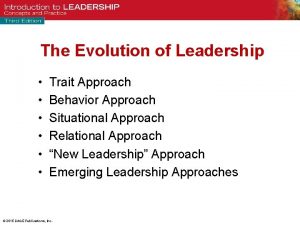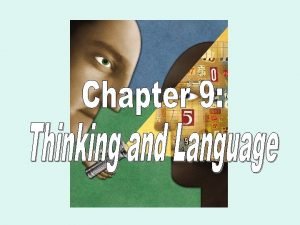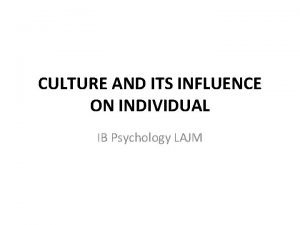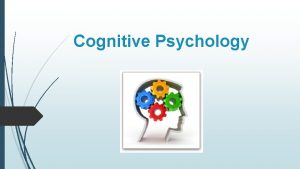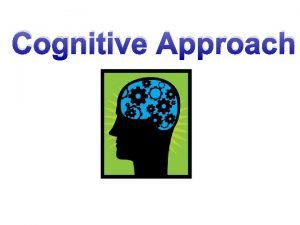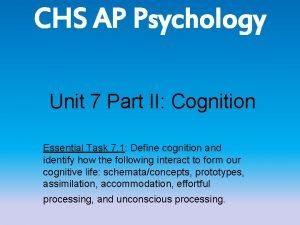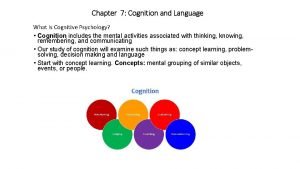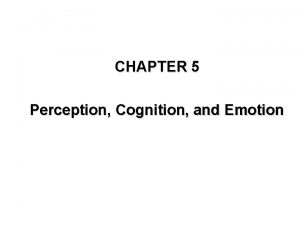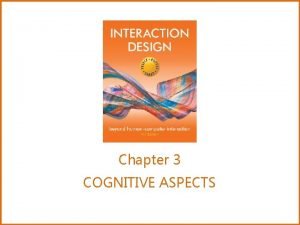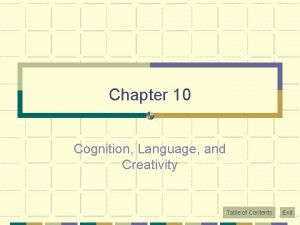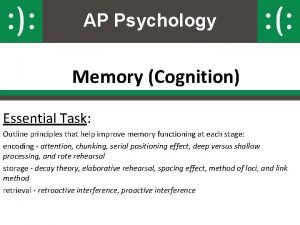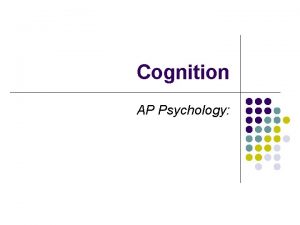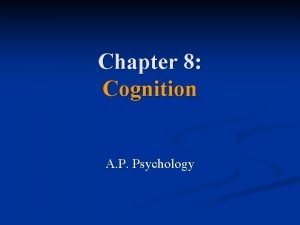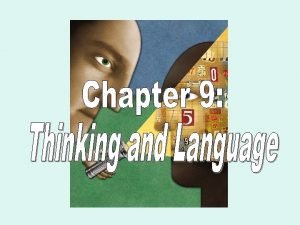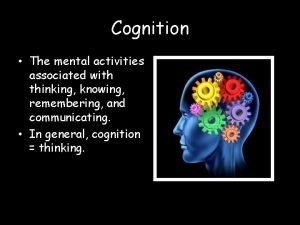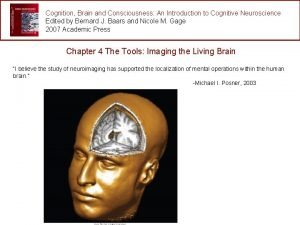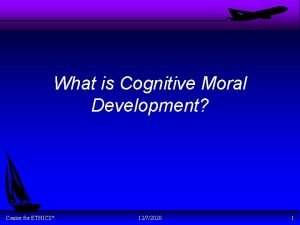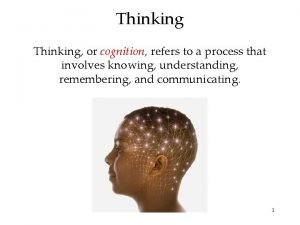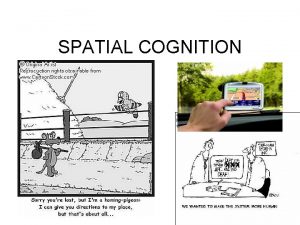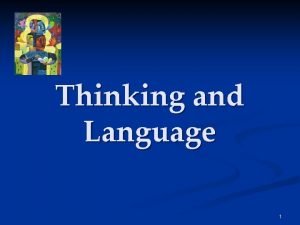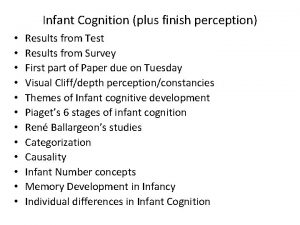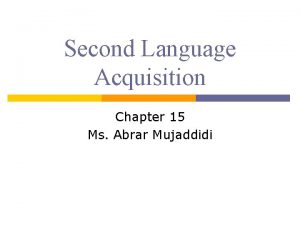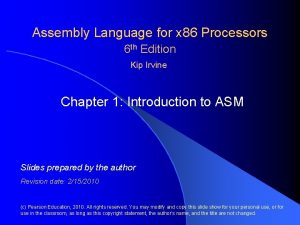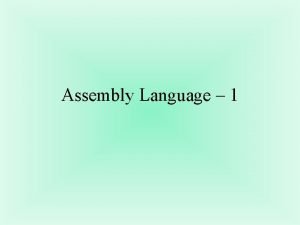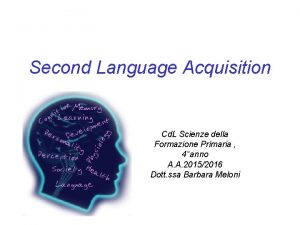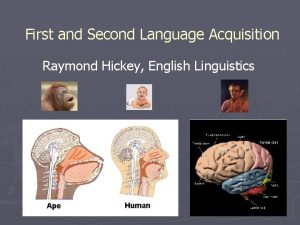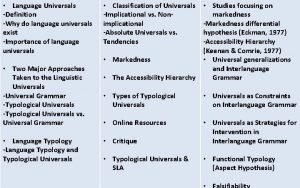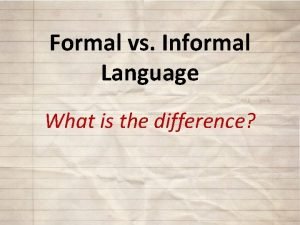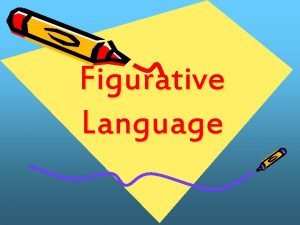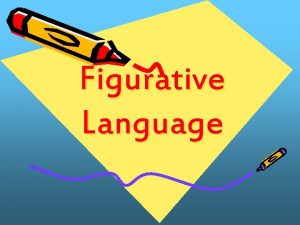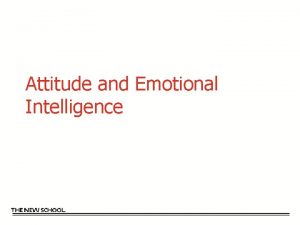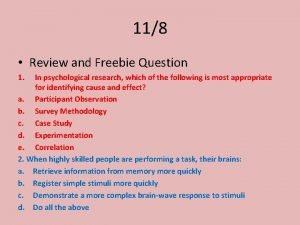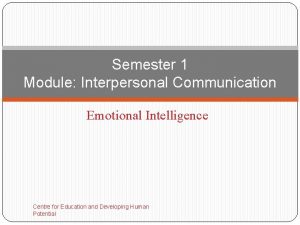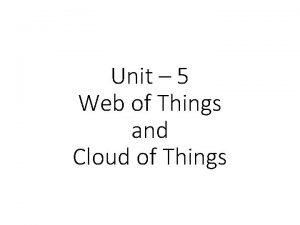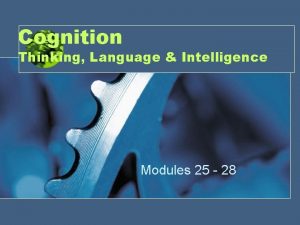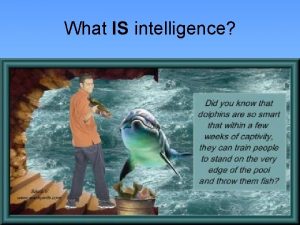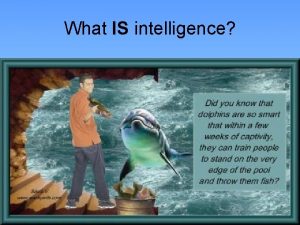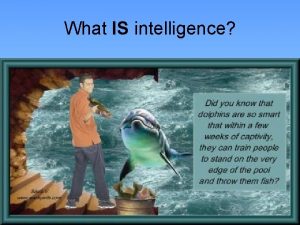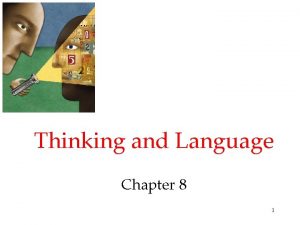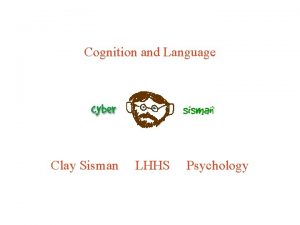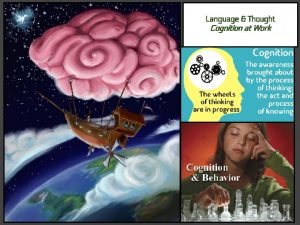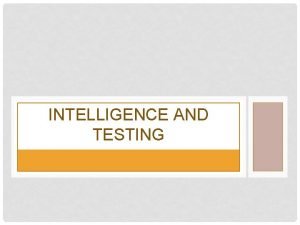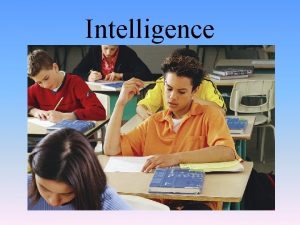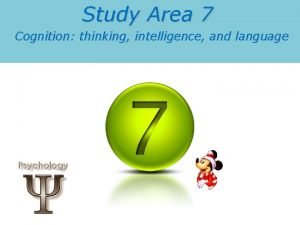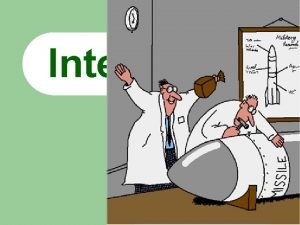Cognition Language and Intelligence Cognition What is Cognition






































































- Slides: 70

Cognition, Language, and Intelligence

Cognition

What is Cognition? • Literally “thinking” • The brain’s representations of information in the world around us • The way the mind processes this information • Sensation → Perception → Cognition


Categories: mental groupings of similar objects, events, and people. “Chair”

Categories · Organize lots of information with a minimum amount of effort · Allow us to solve problems quickly

What determines category membership? Aristotle: Defining features · look for features that every member of the that category possesses · Either is or is not a member of a category Example · Triangle But do categories really fit this definition?

“Chair” What is common to all of them?

Wittgenstein: “Family resemblance” Eleanor Rosch studied how people actually use categories: Prototype model Category membership determined in terms of similarity to “prototypical” exemplars Examples • Chair • Red

Prototype model Categories are not “all or none” Instead, they have graded structure Good example Poor example

Prototype model Categories have “fuzzy” boundaries Chair? Red? Chair? Red?

Prototype properties apply to Natural categories: e. g. , Birds, trees, red Artificial categories: e. g. , Chairs, Aircraft, Weapon

What’s the category? • • Human infant Photo albums Jewelry Dog Insurance documents Computer Painting

What’s the category? Human infant Photo albums Jewelry Dog Insurance documents Computer Painting “Things to take from a burning house” (Barsalou, Ad Hoc Categories) “things to take on a camping trip” “ways to make friends” “possible costumes to wear to a Halloween party” “emergency firewood” · Categorizations made with respect to a goal · Things can be cross-categorized

Levels of Categorization Superordinate Animal Furniture Plant Vehicle Basic Fish Chair Tree Train Subordinate Trout Rocking Chair Oak Tree Freight train Superordinate: Broadest and least specific category. (e. g. , animal, furniture) Basic: More specific, the level of prototypes. A common level of categorization. (e. g. , fish, chair) Subordinate: Most specific type of category, it has the most distinguishing about of information. (e. g. , trout, rocking chair)

Bandwidth-Fidelity Tradeoff Bandwidth • Number of members included • Superordinate categories have the highest bandwidth Fidelity • Number of properties • Subordinate categories have the highest fidelity Basic level categories • Represent best solution to Bandwidth-fidelity tradeoff • Generated first in naming tasks • Learned first by children

Language

• Language – our spoken, written, or gestured words and the way we combine them to communicate meaning

Animal language Why study language in animals? • Communication with animals allows us to learn more about other species • By examining differences across species we can learn about language

Language vs. Communication Many animals (especially social animals) communicate Examples • Bees—“dances” specify distance, direction, & quality of food • Vervet monkeys—Different signals for different predators • Parrots => animals can communicate. BUT can they use language?

What is language? Two conditions must be met: SEMANTICS - ARBITRARY UNITS (WORDS) WHICH HAVE MEANINGS. Hissing cat? Vervet monkey? SYNTAX - WORDS ARE ORGANIZED TOGETHER ACCORDING TO RULES Chomsky: it is syntax that is innately human. Animals can learn words (perhaps) but cannot have a grammar.

Experimental Evidence: can animals be taught to use language? William Furness (1916) – taught orangutan to speak English 3 words: "Cup" "papa" and "thank"

Hayes's (1951): raised a chimp-Vicki-as a human child • tried to teach her English 4 words: "mama" "papa" "cup" & "up" • perhaps chimps do not have coordination and control required to produce spoken language.

Gardners (1969) raised chimp—Washoe—as a human child • Tried to teach A. S. L. (has discrete units and a grammar) • Washoe lived in a trailer behind house for 5 years • Had human companions during all her waking hours

Washoe • Not specifically rewarded for performing a sign • After 4 years had developed 132 A. S. L. signs • apes can meet 1 st criterion for a language - use arbitrary symbols as referents for objects (semantics) BUT could apes do syntax? (organize words together according to grammatical rules) • Not clear whether Washoe could do this

• Washoe prompted investigators to look at syntactic competence • Premack trained female chimp, Sarah, to use plastic chips to communicate. • E. g. , Blue triangle = apple • Was required to give signs in correct order • Rumbaughs trained several chimps to use “lexigrams” to communicate with each humans & with each other => But evidence controversial Used caged chimps Rewarded animals

Nim Chimpsky • 125 ASL words • Made many 2 -word combinations • But did not move on to more complex sentences • 3 -word sentences had no more info than 2 -word sentences • Most utterances prompted by experimenter • Unlike human infants • Chimps merely repeating what E signed • Chimps prodded by experimenters

Rumbaughs • Examined Bonobos (Kanzi) • Learned early in life • Comprehension of 2. 5 year old • Well controlled studies

The experimenter prepares to test Kanzi by placing headphones on his head.

Kanzi listens for spoken English, which comes from another room.

Kanzi generally displays a very intent expression at the moment he recognizes the word.

The experimenter prepares to open a "test booklet" which hold 3 items, one of which corresponds to the word that only Kanzi can hear.

Kanzi gestures with his left hand in a upward motion to signal that he is ready for the test booklet to be shown to him.

Kanzi looks over the photos in the test booklet

Kanzi selects a photograph to indicate which English word he heard through the headphones.

The experimenter congratulates Kanzi on his correct choice.

Human Language • Language related to our thought processes • Behaviorists: thought = language But • People with vocal cords paralyzed can think • So can children and nonhuman adults • So can brain-damaged adults • Today, relation between thought & language more complex =>Language facilitates thought • Some people try to get us to think about differently by using different words. E. g. , politicians: “revenue enhancement”= tax increase

Human Language Other Euphemisms • Oral hygiene appliance • Media courier • Negative patient care outcome • Vertical transportation corps • Social expression products • Preemptive counter attack • Given an alternative career opportunity • Being economical with the truth • Unscheduled terrain encounter

Human Language But do different languages facilitate different thoughts? E. g. , Dani people of New Guinea • 2 basic words for color: mili & mola • So do they have difficult discriminating colors? • “Whorf” hypothesis: Language determines the way we think => people who speak different languages think differently. => Dani should not be able to think about different types of colors. • BUT research (Rosch) shows Dani make as many discriminations between colors as people who have many more basic color terms

Language Development • Genes design the mechanisms for a language, and experience activates them as it modifies the brain Environment: spoken language heard provides input to Genes Brain: design mechanisms for understanding and producing language Behavior: mastery of native language

Learning Foreign Languages Percentage correct on grammar test 100 New language learning gets harder with age 90 80 70 60 50 Native 3 -7 8 -10 11 -15 17 -39 Age at school

Intelligence

What is intelligence? • Cognitive ability → the ability to perform well in cognitive tasks • The ability to use knowledge, solve problems, understand complex ideas, learn quickly, and adapt to environmental challenges

Issues in the study of intelligence • Can intelligence be quantified? • Is it fair to use measures of intelligence in situations that can affect people’s life outcomes? • Is intelligence more determined by genetics or environmental factors? • Are their racial differences in intelligence?

Francis Galton British scientist who wrote “Hereditary Genius” in 1869, suggesting that genius is heritable because it runs in families 1. Intelligence is quantifiable (i. e. , numerical values can be assigned to distinguish between people’s level of intelligence) Frequency 2. Differences among people form a Bell shaped curve Low Intelligence High

Francis Galton 3. Intelligence can be measured by objective tests 4. People’s scores on different tests are correlated Founded “Eugenics”: advocates improving human species by applying evolutionary theory to encourage “biologically superior” people to interbreed

Alfred Binet France, 1904: Commissioned to develop techniques to identify children in need of special education Designed first intelligence test (series of short tasks not relying on reading skills) Did not believe intelligence was fixed or inherited

Lewis Terman Stanford University, 1916: Brought Binet’s intelligence test to US → Stanford-Binet test Designed to be administered in a standardized fashion to large numbers of people E. g. , Immigrants at Ellis Island; 1. 75 million soldiers in WW 2

Immigrants measured according to country of origin Nordics > Southern Europeans & Slavs > Blacks => stricter immigration policy in 1924 But this was overlooked: Blacks from Northern states > Blacks from Southern states Europeans in US for longer > those in US for shorter period

Examples of items on Stanford-Binet Test Age Sample test item 2 Here are some pegs of different sizes and shapes. See whether you can put each one into the correct hole 4 Why do people live in houses? 6 Here are some candies. Can you count how many there are? 10 Why should people be quiet in the library? 12 What does “regret” mean? 14 What is the similarity between high and low?

What does an IQ test reflect? Intelligence Quotient (IQ) = Mental Age X 100 Chronological Age E. g. , If you had a mental age of 10 when you were 8 years old, you IQ would be 125 IQ = M. A. X 100 = 10 X 100 = 125 C. A. 8 IQ range 100 90 -110 above 120 below 70 average normal range superior developmentally disabled

What does an IQ test reflect? An example of an IQ test (though not a good one) is the SAT 2 sets of multiple choice items (verbal & quantitative) Can we improve our SAT scores with coaching? Yes, but not by much: 10 -20 points on the normal 200 -800 range

What do we mean by “intelligence? ” • What does the Stanford-Binet test actually measure? • What do we want to measure with IQ tests? • What do modern IQ tests measure? • Are IQ tests valid? (Do they measure what they are intended to measure? )

The “g” factor Spearman Logical s Mechanical s g Arithmetical s Spatial s

What does “g” determine? • • • Educational achievement Occupation Income level Probability of divorce Health Longevity

What determines “g”? • Which of the following factors do you think are associated with schoolaged children’s performance on standardized test scores? – The child has highly educated parents – The child’s family is intact – The child’s parents have high socioeconomic status – The child’s parents recently moved to a better neighborhood – The child’s mother was thirty or older at the time of her first child’s birth – The child’s mother didn’t work between birth and kindergarten – The child had low birthrate – The child attended Head Start – The child’s parents speak English in the home – The child’s parents regularly take him to museums – The child is adopted – The child is regularly spanked – The child’s parents are involved in the PTA – The child frequently watches television – The child has many books in his home – The child’s parents read to him nearly every day

• • • • The child has highly educated parents The child’s family is intact The child’s parents have high socioeconomic status The child’s parents recently moved to a better neighborhood The child’s mother was thirty or older at the time of her first child’s birth The child had low birthweight The child attended Head Start The child’s parents speak English in the home The child’s parents regularly take him to museums The child is adopted The child is regularly spanked The child’s parents are involved in the PTA The child frequently watches television The child has many books in his home The child’s parents read to him nearly every day

What determines “g”? • Genetics? • Environment? • Genetics + environment (education + nutrition + culture + family + brain exercise…) • But how great is the role of genetics?

Genetic influences on intelligence Monozygotic (identical) twins Dizygotic (franternal) twins

Are there racial differences in intelligence? • Reasons to consider the question: – Genetics do affect intelligence – Races differ genetically, though not by much – Reliable group differences have been found – What causes group differences? – It is a testable question

Are there racial differences in intelligence? Reliable differences have been found on IQ scores between racial groups. In America today: Average IQ score Blacks 85 Hispanics 94 Whites 100 Asians 106 Ashkenazi Jews 109 [keep in mind that these scores are averages for entire population -some Blacks score higher than some Asians on IQ tests]

Herrnstein & Murray (1994): “The Bell Curve” Evidence from large group of white subjects, followed for 10 years high IQ scores predicted getting into a good college, success in college, getting a good job, and success at the job low IQ scores predicted having illegitimate children, going on welfare, and committing a crime Pointed out 2 things we have already noted: Intelligence is heritable There are differences in IQ between racial groups Conclusion: racial differences in IQ are due genetic differences and that these genetic differences explain behavioral differences between races.

Possible explanations for observed racial differences in IQ scores 1. Blacks are genetically predisposed to have lower IQ BUT within-group differences do not explain between group genetic effects Variation within group Poor soil Fertile soil Differences between groups

Possible explanations for observed race differences in IQ scores 1. Blacks are genetically predisposed to have lower IQ 2. Blacks & whites are raised in different environments (physical & psychological) When blacks & whites matched for socioeconomic factors, IQ differences diminish But could matching ever be complete?

Claude Steele Stanford University “Stereotype threat”: fear of doing something that would inadvertently confirm a negative stereotype Experiment: IQ-matched Black & white subjects take difficult test Condition A Told nothing Condition B Told no race differences Blacks do relatively poorly No differences between Blacks & Whites

Possible explanations for observed race differences in IQ scores 1. Blacks are genetically predisposed to have lower IQ 2. Blacks & whites are raised in different environments (physical & psychological) 3. Tests are racially biased

Gosling’s Intelligence Test (GIT) 1. In a game of cricket, David scored all of his 22 runs from sixes and boundaries. He got one six. How many boundaries did he score? 2. Who designed St. Paul’s cathedral in London? 3. What is the official address of the British Prime Minister? 4. Red is to the Central Line as is to the Northern Line 5. Neil Kinnock was to Margaret Thatcher as is to Tony Blair. 6. In David’s second innings he had to run all 5 of his runs. How many yards did he run? 7. What kind of programs would you expect to hear on BBC radio 3? 8. David Gower was to cricket as Will Carling was to ? 9. Andrew is to Scotland as is to Wales 10. If Ophelia traveled at the speed limit on a motorway for two hours, how many miles will she have traveled?

Possible explanations for observed race differences in IQ scores 1. Blacks are genetically predisposed to have lower IQ 2. Blacks & whites are raised in different environments (physical & psychological) 3. Tests are racially biased In terms of common IQ tests, evidence for bias is mixed – most modern tests are not biased, though historically, many tests have been Conclusions: Genetic factors clearly play a role in people’s intelligence, but there is no clear evidence that genetic factors account for observed IQ differences in Black & White Americans


Genetic Relatedness and IQ Correlation Text
 Chapter 7 cognition thinking intelligence and language
Chapter 7 cognition thinking intelligence and language Chapter 7 quiz cognition thinking intelligence and language
Chapter 7 quiz cognition thinking intelligence and language Cognition language and intelligence
Cognition language and intelligence 1. the ability to produce valued outcomes in a novel way
1. the ability to produce valued outcomes in a novel way Thinking, language and intelligence psychology summary
Thinking, language and intelligence psychology summary Example of practical intelligence
Example of practical intelligence Statistical learning ap psychology
Statistical learning ap psychology Thinking affects our language, which then affects our:
Thinking affects our language, which then affects our: Chapter 8 thinking language and intelligence
Chapter 8 thinking language and intelligence Thinking intelligence and language
Thinking intelligence and language Module 29 biology cognition and learning
Module 29 biology cognition and learning Teacup ib psychology
Teacup ib psychology Cognition and personalization
Cognition and personalization Language intelligence
Language intelligence Intelligence includes having good language skills
Intelligence includes having good language skills Belief perseverance
Belief perseverance Poor insight and judgement examples
Poor insight and judgement examples Mse in counseling
Mse in counseling Delavario et al (2013)
Delavario et al (2013) What is cognition
What is cognition Cognition definition
Cognition definition Cognition definition ap psychology
Cognition definition ap psychology What is cognition
What is cognition Cognition vs perception
Cognition vs perception Altered cognition in older adults is commonly attributed to
Altered cognition in older adults is commonly attributed to What is cognition
What is cognition Cognition definition
Cognition definition Embodied cognition ap psychology
Embodied cognition ap psychology Assimilation ap psychology
Assimilation ap psychology Jalan pintas mental
Jalan pintas mental Unlike b.f. skinner, noam chomsky believes that children
Unlike b.f. skinner, noam chomsky believes that children Ap psych unit 7 part 2
Ap psych unit 7 part 2 Embodied cognition ap psychology
Embodied cognition ap psychology Cognition refers to
Cognition refers to The mental activities associated with thinking
The mental activities associated with thinking Complex cognition
Complex cognition Moral cognition
Moral cognition Cognitive dissonance
Cognitive dissonance Xxxفضایی
Xxxفضایی Cognition refers to
Cognition refers to Cognition plus
Cognition plus B.i.ø
B.i.ø Monitor model
Monitor model Difference between second language and foreign language
Difference between second language and foreign language Standard language examples
Standard language examples Assembler in computer
Assembler in computer Difference between assembly language and machine language
Difference between assembly language and machine language Language
Language Formal vs informal vocabulary
Formal vs informal vocabulary What is the language in
What is the language in Difference of first language and second language
Difference of first language and second language Language
Language Non implicational universals
Non implicational universals Characteristic of formal language
Characteristic of formal language Literal vs figurative language
Literal vs figurative language What was the first human language
What was the first human language Figurative language shampoo
Figurative language shampoo Difference between crystalized and fluid intelligence
Difference between crystalized and fluid intelligence Strategic & competitive intelligence professionals
Strategic & competitive intelligence professionals What math is used in artificial intelligence
What math is used in artificial intelligence Informed and uninformed search
Informed and uninformed search Decision support and business intelligence systems
Decision support and business intelligence systems Business intelligence and performance management
Business intelligence and performance management Attitude and emotional intelligence
Attitude and emotional intelligence Head size and intelligence
Head size and intelligence Interpersonal communication and emotional intelligence
Interpersonal communication and emotional intelligence Introduction to artificial intelligence and expert systems
Introduction to artificial intelligence and expert systems Rfid and business intelligence
Rfid and business intelligence Rfid and business intelligence
Rfid and business intelligence Wot portals and business intelligence
Wot portals and business intelligence Missile and space intelligence center phone number
Missile and space intelligence center phone number

